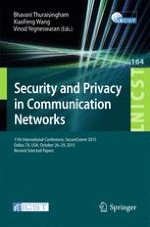2015 | Buch | 1. Auflage
Security and Privacy in Communication Networks
11th EAI International Conference, SecureComm 2015, Dallas, TX, USA, October 26-29, 2015, Proceedings
herausgegeben von: Bhavani Thuraisingham, XiaoFeng Wang, Vinod Yegneswaran
Verlag: Springer International Publishing
Buchreihe : Lecture Notes of the Institute for Computer Sciences, Social Informatics and Telecommunications Engineering
